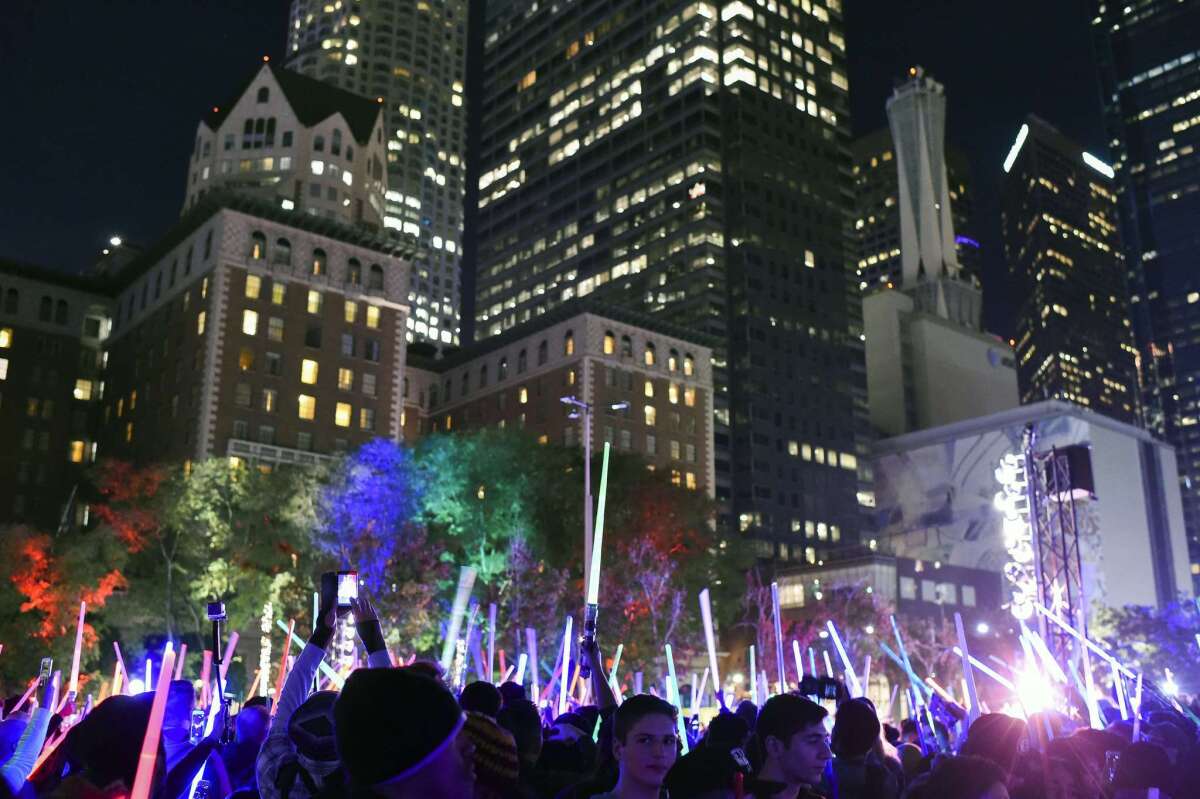Op-Ed: Why did I pay $30 to see ‘Star Wars’?

Thousands attend a lightsaber battle in downtown L.A.’s Pershing Square to celebrate the opening weekend of the new movie “Star Wars: The Force Awakens.”
A few days ago, as I bought tickets to “Star Wars: The Force Awakens,” I paused briefly to wonder what I was doing. Why was I paying dearly — $30 for each seat — to see “Star Wars” in 3-D? I wasn’t a particularly enthusiastic fan of the originals. I wasn’t desperate to watch a J.J. Abrams-directed light saber battle. Ultimately, I realized, I was going to see “The Force Awakens” because all my friends were going to see it, and everyone else’s friends were going to see it too. I was in the grip of an increasingly rare phenomenon: A true mass-cultural event.
In the Internet age, it’s difficult to even define what’s mainstream. Yes, we still have pop stars who are so famous they only need a first name, and songs that seem omnipresent even if we’ve never downloaded them on iTunes or searched for them on YouTube. And, yes, new movies still become touchstones — just think about all those “Frozen”-obsessed kids. Yet touchstones are harder than ever to manufacture, because there are more entertainment options than ever.
In the Internet age, it’s difficult to even define what’s mainstream.
Thirty-eight years ago, when the first “Star Wars” came out, consumers were limited to the channels in their cable package, the films at their local theater and in video stores, and the books in their local libraries and bookstores. The enterprising viewer could use her VCR to record movies and television for later consideration, but limited options and tightly controlled distribution meant that most people experienced the same cultural events at the same time.
I was born five years after the first “Star Wars” premiered, and, like many if not most members of my generation, I revel in fragmentation. I watch television but I don’t have cable; instead I stream shows on Netflix and Hulu. I listen to podcasts more often than public radio. I enjoy the “Saturday Night Live” skits that get sent around, but I haven’t sat down for a full episode in years. I keep up with the Kardashians on Instagram, not Bravo. And I see only about five films in the theater per year, which actually makes me an avid moviegoer, statistically speaking. The average American sees just three or four.
None of which is to say I’m immune to trends. It’s just that I feel more pressure to connect with my friends than society at large. This year, that meant watching Drake’s “Hotline Bling” video (and all of the resulting GIFs), and tracking DJ Khaled’s latest Snapchats. It meant reading Elena Ferrante’s Neapolitan novels. I didn’t watch “The Jinx” — the HBO documentary miniseries about Robert Durst — and felt downright rebellious; but I felt no qualms about skipping “The Big Bang Theory” — which was one of this year’s most-watched television shows.
What matters now isn’t the zeitgeist, it’s the social network. If my network hadn’t endorsed the new “Star Wars,” I might not have gone to seen it. Unusually, however, it was anointed both by my network and, seemingly, everyone else’s network as a must-see movie. “The Force Awakens” brought in a record-breaking $248 million in its opening weekend.
“To see ‘Star Wars’ in 1977 was to experience a moment in pop culture that seemed universal,” wrote the film critic Jim Emerson in 2007. In 2015, something can seem universal even if only you, your friends and your family are participating. But George Lucas’ characters are clearly still universal in the 1977 sense.
“Star Wars,” the contemporary franchise, of course benefits from the fact that the brand dates back to a long time ago and a culture that feels far, far away — a culture that had fewer options. It broke out at a less competitive time. Perhaps the movie has drawn mass attention for another reason, too. It offers fragmented audiences a chance to remember what it feels like to be a part of something big that crosses cultural and generational lines.
In other words, “The Force Awakens” is so popular because everyone knew it would be so popular.
Although I’ll continue to enjoy my Drake GIFs, Ferrante novels and streaming shows, I’m also happy I hustled to the theater for “Star Wars.” It’s nice to leave your niche and experience the truly universal once in a while.
Ann Friedman is a contributing writer to Opinion.
Follow the Opinion section on Twitter @latimesopinion and Facebook
More to Read
A cure for the common opinion
Get thought-provoking perspectives with our weekly newsletter.
You may occasionally receive promotional content from the Los Angeles Times.










